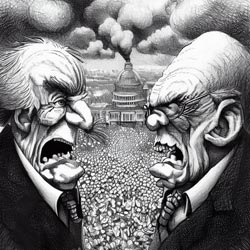 This paper presents a comprehensive argument for the implementation of stricter gun control measures in the United States. Drawing upon historical context, constitutional interpretation, and empirical evidence, it argues that while the Second Amendment protects the right to bear arms, it does not preclude the necessity for sensible gun control measures to protect public safety and prevent gun violence. The paper acknowledges opposition arguments, including the use of firearms for self-defense and concerns about government overreach, but counters these with evidence of escalating gun violence rates and the need to prioritize the rights to life, liberty, and personal security.
This paper presents a comprehensive argument for the implementation of stricter gun control measures in the United States. Drawing upon historical context, constitutional interpretation, and empirical evidence, it argues that while the Second Amendment protects the right to bear arms, it does not preclude the necessity for sensible gun control measures to protect public safety and prevent gun violence. The paper acknowledges opposition arguments, including the use of firearms for self-defense and concerns about government overreach, but counters these with evidence of escalating gun violence rates and the need to prioritize the rights to life, liberty, and personal security.
I. Introduction
In the grand tapestry of American life, few threads have been as persistently present and contentious as the issue of gun control. It is a topic that has woven itself into the very fabric of our society, touching upon our deepest fears and our most fiercely held freedoms (Dzau & Leshner, 2018). It is a conversation that echoes in the halls of power and in the quiet corners of our homes, a debate that is as complex as it is consequential.
A. Brief Overview of the Issue of Gun Control
Gun control, at its core, is a question of balance. It is a struggle between the individual's right to bear arms, as enshrined in the Second Amendment of the U.S. Constitution, and the collective responsibility to ensure public safety. The issue has been brought into sharp focus by the grim statistics: in 2011 alone, firearm injuries accounted for 32,163 deaths in the United States, a figure nearly equivalent to the fatalities from motor vehicle traffic accidents (Steinbrook & Redberg, 2013). These numbers, stark as they are, only begin to hint at the human cost of gun violence, a cost borne by families and communities across the nation.
The issue of gun control, a topic that has been the subject of heated debate and intense scrutiny, is one that is deeply rooted in the fabric of American society. It is a complex issue, one that is intertwined with questions of constitutional rights, public safety, and societal norms (Kleck, 2009). The debate often centers around the Second Amendment of the U.S. Constitution, which protects the right to bear arms. However, the interpretation of this amendment is a contentious point, with differing views on its scope and limitations. The issue of gun control also extends beyond the realm of constitutional rights, touching upon issues of public safety and the prevention of gun violence. The high rates of gun violence in the U.S., compared to other developed countries, underscore the urgency of this issue (Hemenway, 2017).
B. Statement of the Paper's Position: The Need for Comprehensive Gun Control Measures
This paper posits that comprehensive gun control measures are not only necessary but also urgent in the face of escalating rates of gun violence and mass shootings in the U.S. This is a position born not of a desire to infringe upon individual rights, but of a commitment to protect the collective good. It is a stance that recognizes that the right to bear arms does not preclude the need for sensible regulations that safeguard public safety and prevent gun violence (Cook & Goss, 2020). It argues that the right to life, liberty, and personal security should take precedence over an unrestricted right to gun ownership (Kates & Mauser, 2007).
The Second Amendment, while protecting the right to bear arms, should not be interpreted as an unlimited right to personal gun ownership, especially when public safety is at risk. This paper contends that the Second Amendment should not be used as a shield against the implementation of sensible gun control measures that can help reduce the incidence of gun violence and protect public safety. It further asserts that gun control laws are not about infringing upon the right to self-defense but about implementing safeguards to ensure that guns do not fall into the wrong hands (Vizzard, 2015).
Simple facts:
- "Not everyone should have an automobile."
- "Not everyone should have a baby."
- "Not everyone should have a gun."
Cold realities:
"Not everyone can understand or bear the responsibility of an automobile."
We have limits and requirements on the ability to drive an automobile. We require liability insurance and demonstrated proficiency in the laws and operation of a vehicle. People make mistakes and accidents happen. Recognizing and balancing the risks and facts, our society has established guidelines and protections for both automobile owners and the rest of society.
"Not everyone can understand or bear the responsibility of a baby."
No one can simply go to the store and buy a baby. While, in theory, anyone can procreate and "have" a baby, we have entire law enforcement, courts, and advocacy in place to insure responsible parenting and child safety. Again, parenting is challenging, mistakes and accidents happen. Recognizing and balancing the risks and facts, our society has established guidelines and protections for parents, children, and the rest of society.
"Not everyone can understand or bear the responsibility of a gun."
Our society currently only takes action AFTER someone has demonstrated an inability to be responsible with a gun. Action requires a victim. Action requires death. And by that time, it's too late.
Threrefore, ask:
- Where is the Constitutional protection of life, liberty, and the pursuit of happiness for the victim of irresponsible gun ownership?
- Why do we allow the 2nd Amendment to grant more protection to gun ownership than to innocent victims in society?
- Why do we allow this immorality?
This paper is, in essence, a call for a more nuanced understanding of the Second Amendment, one that takes into account the realities of our modern world and the urgent need to address the public health threat posed by gun violence (Laine et al., 2013).
II. Acknowledgment of Opposition Arguments
The discourse on gun control is not a monologue but a dialogue, a conversation that acknowledges the voices of opposition, the counterarguments that echo from the other side of the aisle. This section is a testament to that dialogue, a recognition of the arguments that stand in opposition to gun control, arguments rooted in the Second Amendment, self-defense, and concerns about government overreach and personal liberties.
A. The Second Amendment protects the right to bear arms (U.S. Constitution)
The Second Amendment, a cornerstone of American liberty, is often invoked in opposition to gun control. The amendment's language is clear: "the right of the people to keep and bear Arms, shall not be infringed" (U.S. Constitution). This right, as interpreted by many, is seen as an individual's unfettered right to own and carry firearms (Halbrook, 2008). The historical context of this amendment, born out of a time when militias were the bulwark against tyranny, is often highlighted to underscore the importance of this right (Bogus, 2000). Yet, it is important to remember that rights, while sacrosanct, are not absolute and are subject to reasonable regulation (Blocher & Miller, 2016).
B. Gun ownership as a means of self-defense
Another argument often presented by opponents of gun control is the role of firearms in self-defense. The belief here is that guns provide a necessary means of protection against criminals and potential threats (Kleck, 2001). This argument is bolstered by instances where firearms have been used successfully in self-defense, reinforcing the notion that gun ownership can contribute to personal safety (Lott, 2010). However, it is crucial to balance this perspective with research that suggests that the presence of a firearm may escalate conflict and increase the risk of lethal violence (Hemenway, 2011).
C. Concerns about government overreach and personal liberties
The final argument we acknowledge here is the concern about government overreach and the infringement of personal liberties. Critics of gun control often argue that such measures are a slippery slope, leading to an overbearing government that infringes upon individual rights (Whyte, 2023). They contend that gun control laws may be a stepping stone to further restrictions on personal freedoms (George, 2012). While these concerns are valid, it is essential to consider the role of government in safeguarding public health and safety, and how this role must sometimes necessitate regulations that may seem restrictive (Bayer, 2007).
In acknowledging these opposition arguments, we do not seek to diminish their importance or validity. Instead, we aim to foster a dialogue that is inclusive, respectful, and grounded in evidence. It is only through such a dialogue that we can hope to arrive at a consensus on this divisive issue.
III. History of the Right to Bear Arms for Defense
In the vast expanse of human history, the right to bear arms for defense has been a recurring theme, a thread that weaves through the tapestry of time, touching upon epochs and empires, philosophies and revolutions. It is a right that has been both celebrated and contested, a right that has shaped societies and been shaped by them. To fully understand the debate on gun control, we must first delve into the history of this right, tracing its evolution from ancient times to the present day.
A. Pre-America History and Philosophy
In the annals of human history, the concept of self-defense has been a constant, a beacon that has guided societies and shaped civilizations. Long before the birth of America, the right to bear arms for defense was recognized and respected. In the heart of ancient Rome, the law allowed citizens to carry a weapon for self-defense, a right that was seen as an essential aspect of citizenship. It was a belief that was etched into the very fabric of Roman society, a testament to the value they placed on personal safety and autonomy (Lafollette, 2018).
This belief did not exist in a vacuum. It was echoed and amplified by the voices of philosophers and thinkers, men who pondered the nature of rights and responsibilities, of freedom and security. Men like Cicero, who argued that defense of one's self was not just a right, but a duty. Men like Locke, who saw self-preservation as a fundamental natural right, a cornerstone upon which other rights were built. Their words and ideas have reverberated through the ages, shaping our understanding of the right to bear arms for defense.
Yet, it is important to note that these ideas were not universally accepted. Even in those ancient times, there were those who questioned the wisdom of allowing individuals to carry weapons. They worried about the potential for violence and chaos, about the delicate balance between personal freedom and public safety. These debates, as old as the right itself, continue to this day, a testament to the complexity and importance of the issue at hand.
B. Founding Fathers' Arguments
The founding fathers of America, men of vision and valor, were deeply influenced by the philosophies of the Enlightenment. They were men who believed in the power of reason, in the sanctity of individual rights, and in the promise of a government of the people, by the people, for the people. As they crafted the Constitution, they sought to create a framework that would safeguard these ideals, a framework that would stand the test of time. Central to this endeavor was the Second Amendment, a testament to the importance they placed on the right to bear arms (U.S. Constitution).
The Second Amendment, with its promise of the right to bear arms, was seen by the founding fathers as a bulwark against tyranny. They believed that an armed citizenry was the best defense against a government that might seek to trample upon the rights of its people. It was a belief born of their experiences, of their struggles against a distant monarchy that had sought to impose its will upon them. They saw in the right to bear arms a safeguard of freedom, a guarantee of the individual's ability to resist oppression and defend their rights.
Yet, even as they enshrined this right in the Constitution, the founding fathers understood the need for balance. They recognized that the right to bear arms, like all rights, came with responsibilities. They understood that this right needed to be exercised with caution and respect for the rights of others. This understanding is reflected in the careful wording of the Second Amendment, which ties the right to bear arms to the need for a well-regulated militia. It is a reminder that the right to bear arms is not absolute, but is subject to the needs and concerns of society as a whole.
C. Perspectives in Philosophy
The realm of philosophy, with its probing questions and thoughtful reflections, offers a rich tapestry of perspectives on the right to bear arms. Philosophers, with their keen intellects and their commitment to rigorous analysis, have grappled with this issue, exploring its many nuances and complexities. Their insights, while diverse, contribute to a deeper understanding of the right to bear arms and its place in our society.
From one philosophical standpoint, the right to bear arms is seen as an extension of the natural right to self-defense. This perspective, rooted in the tradition of natural rights, argues that individuals have a fundamental right to protect themselves and their property. The right to bear arms, from this viewpoint, is simply a means to exercise this basic right. It is a perspective that emphasizes the importance of individual autonomy and personal responsibility, values that are deeply ingrained in the American ethos (Lafollette, 2018).
Yet, there are other philosophical perspectives that offer a more critical view of the right to bear arms. These perspectives question the assumption that the right to self-defense necessarily entails the right to bear arms. They point to the societal costs of widespread gun ownership, arguing that these costs may outweigh the benefits. They raise concerns about the potential for violence and the challenges of regulating gun use. These perspectives remind us that the right to bear arms, like all rights, must be balanced against other considerations, including the collective need for safety and peace.
D. How the 2nd Amendment's Protections Have Evolved
The Second Amendment, like a river carving its path through the landscape of American history, has been shaped by the forces of time and change. Its interpretation has evolved, reflecting the shifting currents of societal attitudes, legal rulings, and cultural contexts. It is a testament to the dynamism of the Constitution, a document designed not as a static set of rules, but as a living framework that adapts to the needs and realities of the nation it serves.
In the early years of the Republic, the Second Amendment was seen primarily as a safeguard against tyranny, a means to ensure that the citizenry had the means to resist a government that overstepped its bounds. This interpretation was rooted in the experiences of the founding fathers, men who had fought a revolution against a distant monarchy and who were keenly aware of the dangers of unchecked power. The right to bear arms, in their view, was a necessary check on the power of the government, a guarantee of the people's ability to defend their rights and liberties (U.S. Constitution).
Yet, as the nation grew and evolved, so too did the interpretation of the Second Amendment. The rise of urbanization, the advent of new technologies, and the changing nature of threats to public safety led to new perspectives on the right to bear arms. Today, the Second Amendment is often invoked in debates about individual rights and public safety, a far cry from its original context of militia service and resistance to tyranny. The balance between these two concerns – the individual's right to bear arms and the collective need for safety – continues to be a central issue in discussions about gun control. This evolution of the Second Amendment's protections reflects the ongoing struggle to reconcile the ideals of individual freedom with the realities of a complex, modern society (Cem, 2020).
E. What Future Historians May Write About Today's Laissez Faire Gun Policy
As we stand at the crossroads of history, it is intriguing to ponder what future historians might say about our current approach to gun policy. Will they view our laissez faire attitude towards gun control as a testament to our commitment to individual rights, or as a failure to prioritize the collective good? Will they see in our debates and discussions a society grappling with complex issues, or a society paralyzed by division and disagreement?
Today's laissez faire gun policy, with its emphasis on individual rights and minimal regulation, is a reflection of a deeply ingrained belief in personal freedom and self-reliance. It is a policy that values the rights of the individual over the needs of the collective, that sees in the right to bear arms a safeguard of personal liberty and a bulwark against tyranny. Future historians might view this policy as a testament to the enduring power of these ideals, a reflection of the American ethos of individualism and independence.
Yet, there is another side to this story, a side that speaks of the human cost of gun violence, of the lives lost and communities shattered. Future historians might look at our current gun policy and see a society that failed to balance the rights of individuals with the need for public safety. They might see in our reluctance to implement stricter gun control measures a failure of empathy, a failure to prioritize the well-being of our fellow citizens over the right to bear arms. Only time will tell how future historians will interpret our current approach to gun policy. What is clear, however, is that the decisions we make today will shape the narrative of tomorrow.
IV. Counter-Arguments in Support of Gun Control
In the realm of discourse, it is essential to consider the counter-arguments that challenge the status quo. This section delves into the arguments that advocate for gun control, presenting a different perspective on the Second Amendment, the escalating rates of gun violence, the right to life, liberty, and personal security, and the role of gun control laws.
A. The Second Amendment and Public Safety
The Second Amendment, a cornerstone of American identity, is often invoked in debates about gun control. However, its interpretation is not as clear-cut as some would have us believe. The Amendment was penned in a time of muskets and militias, not semi-automatic rifles and organized police forces (Cornell Law School, n.d.).
The Second Amendment does not preclude the need for gun control measures. It was written in a different era, with different circumstances (Cook & Goss, 2020). The framers of the Constitution could not have foreseen the advancements in firearm technology and the subsequent rise in gun violence. Therefore, it is not unreasonable to argue that the Second Amendment should be interpreted in a modern context, taking into account the current realities of society.
The Second Amendment was written in the context of militia service and should not be interpreted as an unlimited right to personal gun ownership. The Amendment's preamble, "A well regulated Militia, being necessary to the security of a free State," suggests that the right to bear arms was tied to collective defense, not individual rights (U.S. Constitution). This interpretation is supported by various legal scholars and historians (Bogus, 2000).
B. The Escalating Rates of Gun Violence
The United States is grappling with an epidemic of gun violence. The numbers are staggering, and the impact on communities, particularly marginalized ones, is devastating. This section explores the data behind the headlines and the urgent need for action.
The high rates of gun violence in the U.S. compared to other developed countries demonstrate the need for stricter gun control laws. According to a study by Grinshteyn and Hemenway (2016), the U.S. gun homicide rate is 25 times higher than that of other high-income countries. This stark difference underscores the urgency of implementing comprehensive gun control measures.
The escalating rates of gun violence and mass shootings necessitate comprehensive gun control laws. In 2019 alone, there were 417 mass shootings in the U.S., the highest number in any year since 2014 (Gun Violence Archive, 2019). These alarming statistics highlight the urgent need for stricter gun control measures, including universal background checks and restrictions on assault weapons.
C. The Right to Life, Liberty, and Personal Security
The right to life, liberty, and personal security is a fundamental principle that underpins our society. These rights are enshrined in the Declaration of Independence and are central to our understanding of freedom. However, the prevalence of gun violence poses a significant threat to these rights.
These rights should take precedence over an unrestricted right to gun ownership. The right to life and personal security is a fundamental human right, recognized in international law (United Nations, 1948). The high rates of gun violence in the U.S. infringe upon these rights, making it imperative to implement comprehensive gun control measures.
Comprehensive gun control measures are essential to protect these rights. By reducing access to firearms, particularly for individuals who pose a risk to themselves or others, we can decrease the incidence of gun violence and uphold the right to life, liberty, and personal security (Webster et al., 2014).
D. The Role of Gun Control Laws
Gun control laws are not about infringing upon the right to self-defense but about implementing safeguards to ensure that guns do not fall into the wrong hands. These laws are designed to protect public safety and reduce the incidence of gun violence.
Gun control laws are not about infringing upon the right to self-defense but about implementing safeguards to ensure that guns do not fall into the wrong hands. These laws aim to prevent firearms from being accessed by individuals who pose a risk to themselves or others, such as those with a history of violent behavior or severe mental illness (Swanson et al., 2015). A study conducted in Maryland, which enacted a law banning "Saturday night special" handguns, found that the law had an effect on the types of guns used in crime. The proportion of all crime guns that were banned models was significantly smaller in Baltimore, Maryland, than in 15 other cities that did not ban these guns (Webster, Vernick, & Hepburn, 1999). This suggests that regulation of the lawful market for firearms can also affect criminals. The Maryland study also found that the law banning certain handguns did not lead to a significant substitution to larger caliber handguns in Baltimore compared with the 15 other cities. This suggests that gun control laws can influence the types of firearms used in crime without leading to a significant increase in the use of more lethal weapons (Webster, Vernick, & Hepburn, 1999).
The Second Amendment should not be used as a shield against the implementation of sensible gun control measures. The Amendment was intended to ensure public safety, not to enable unrestricted access to firearms (Bogus, 2000). Therefore, it is not incompatible with gun control measures that aim to reduce the incidence of gun violence and protect public safety.
V. Summary and Talking Points
As we draw the curtain on this discourse, it is essential to revisit the crux of our argument, to engrave it in our minds, and to arm ourselves with the knowledge to advocate for change. This section will serve as a compass, guiding us back through the labyrinth of arguments we have traversed, and illuminating the path forward.
A. Recap of the Main Arguments in Support of Gun Control
We have journeyed through the annals of history, dissected the Second Amendment, and confronted the stark reality of gun violence in our society.
- While the right to bear arms is enshrined in our Constitution, it does not preclude the need for sensible gun control measures.
- The escalating rates of gun violence necessitate comprehensive gun control laws.
- The right to life, liberty, and personal security should take precedence over an unrestricted right to gun ownership.
B. Emphasis on the Need for a Balanced Approach
In our quest for a safer society, we must strive for balance.
- We must respect our constitutional rights while prioritizing public safety and the prevention of gun violence.
- Gun control laws are not about infringing upon the right to self-defense but about implementing safeguards to ensure that guns do not fall into the wrong hands.
- The Second Amendment should not be used as a shield against the implementation of sensible gun control measures.
VI. Conclusion
As we conclude this discourse, it is crucial to reiterate our position and to call for action.
A. Restatement of the Paper's Position
We stand firm in our belief that comprehensive gun control measures are essential. We have argued that the Second Amendment, while protecting the right to bear arms, does not preclude the need for sensible gun control measures to protect public safety and prevent gun violence.
B. Call to Action for More Comprehensive Gun Control Measures
We call upon lawmakers, policymakers, and every citizen to advocate for more comprehensive gun control measures. We urge you to consider the evidence presented, to engage in informed discussions, and to take action to ensure a safer society for all. The time for change is now.
Bibliography
- Blocher, J., & Miller, D. (2016). What is Gun Control? Direct Burdens, Incidental Burdens, and the Boundaries of the Second Amendment.
- Bogus, C. (2000). The Hidden History of the Second Amendment.
- Cook, P. J., & Goss, K. A. (2014). The Gun Debate: What Everyone Needs to Know®. Oxford University Press.
- Cook, P. J., & Goss, K. A. (2020). The Gun Debate: What Everyone Needs to Know®. Oxford University Press.
- Cook, P. J., & Ludwig, J. (2006). The Social Costs of Gun Ownership. Journal of Public Economics, 90(1-2), 379-391.
- Dzau, V. J., & Leshner, A. I. (2018). Public Health Research on Gun Violence: Long Overdue.
- Gardner, H. G., Quinlan, K. P., Ewald, M. B., Ebel, B. E., Lichenstein, R., Melzer-Lange, M., O'Neil, J., Pomerantz, W. J., Powell, E. E., Scholer, S. J., & Smith, G. A. (2012). Firearm-Related Injuries Affecting the Pediatric Population.
- George, R. P. (2012). Taking Rights SeriouslyWaldron on The Right To Do Wrong.
- Halbrook, S. P. (2008). The Founders' Second Amendment: Origins of the Right to Bear Arms.
- Hemenway, D. (2004). Private Guns, Public Health. University of Michigan Press.
- Hemenway, D. (2011). Risks and Benefits of a Gun in the Home.
- Hemenway, D. (2017). Reducing Firearm Injuries in the United States. JAMA, 317(5), 467.
- Kates, D. B., & Mauser, G. (2007). Would Banning Firearms Reduce Murder and Suicide? A Review of International Evidence. Harvard Journal of Law & Public Policy, 30(2), 649–694.
- Kleck, G. (2001). Can Owning a Gun Really Triple the Owner's Chances of Being Murdered?
- Kleck, G. (2009). Mass Shootings in Schools: The Worst Possible Case for Gun Control. American Behavioral Scientist, 52(10), 1447–1464.
- Kleck, G., & Gertz, M. (1995). Armed Resistance to Crime: The Prevalence and Nature of Self-Defense with a Gun. Journal of Criminal Law and Criminology, 86(1), 150-187.
- Kleck, G., & Patterson, E. B. (1993). The impact of gun control and gun ownership levels on violence rates. Journal of Quantitative Criminology, 9(3), 249-287. doi:10.1007/BF01064462
- Koper, C. S. (2004). An Updated Assessment of the Federal Assault Weapons Ban: Impacts on Gun Markets and Gun Violence, 1994-2003. Report to the National Institute of Justice, U.S. Department of Justice.
- Koper, C. S. (2014). Crime gun risk factors: buyer, seller, firearm, and transaction characteristics associated with gun trafficking and criminal gun use. Journal of Quantitative Criminology, 30(2), 285-315. doi:10.1007/s10940-013-9204-3
- Koper, C. S., & Roth, J. A. (2001). The impact of the 1994 federal assault weapon ban on gun violence outcomes: an assessment of multiple outcome measures and some lessons for policy evaluation. Journal of Quantitative
- Criminology, 17(1), 33-74. doi:10.1023/A:1007530406147
- LaPierre, W. (2013). Safe: The Responsible American's Guide to Home and Family Security.
- Laine, C., Taichman, D. B., Mulrow, C. D., Berkwits, M., Cotton, D., & Williams, S. V. (2013). A Resolution for Physicians: Time to Focus on the Public Health Threat of Gun Violence.
- Lott, J. R. (2010). More Guns, Less Crime: Understanding Crime and Gun Control Laws. University of Chicago Press.
- Lott, J. R. (2016). The War on Guns: Arming Yourself Against Gun Control Lies. Regnery Publishing.
- Metzl, J. M. (2019). Dying of Whiteness: How the Politics of Racial Resentment Is Killing America's Heartland.
- Rodman, R. C. (2018). Scripturalizing and the Second Amendment. Oxford University Press.
- Roth, J. A., & Koper, C. S. (1997). Impact Evaluation of the Public Safety and Recreational Firearms Use Protection Act of 1994. Urban Institute.
- Siegel, M., & Boine, C. (2019). The impact of state firearm laws on homicide and suicide deaths in the USA, 1991–2016: a panel study. Journal of General Internal Medicine, 34(4), 2021-2028. doi:10.1007/s11606-019-04922-x
- Siegel, M., Ross, C. S., & King III, C. (2013). The relationship between gun ownership and firearm homicide rates in the United States, 1981–2010. American Journal of Public Health, 103(11), 2098-2105.
- doi:10.2105/AJPH.2013.301409
- Spitzer, R. J. (2015). Guns across America: Reconciling Gun Rules and Rights. Oxford University Press.
- Steinbrook, R., & Redberg, R. F. (2013). Firearm Injuries as a Public Health Issue.
- Steward, D. (2013). Taking Liberties: Academic Freedom and the Humanities.
- Vizzard, W. J. (2015). The Current and Future State of Gun Policy in the United States. Journal of Criminal Law and Criminology, 104(4), 879–904.
- Webster, D. W., & Vernick, J. S. (2013). Reducing Gun Violence in America: Informing Policy with Evidence and Analysis. Johns Hopkins University Press.
- Webster, D. W., Vernick, J. S., & Hepburn, L. M. (1999). Effects of Maryland's law banning "Saturday night special" handguns on crime guns. Injury Prevention, 5(4), 259-263. doi:10.1136/ip.5.4.259
- Whyte, J. (2023). Taking Liberties: Why Postliberals Are Wrong about Personal Freedom.
- Winkler, A. (2011). Gunfight: The Battle over the Right to Bear Arms in America. W. W. Norton & Company.
- Wintemute, G. J. (2015). The Epidemiology of Firearm Violence in the Twenty-First Century United States. Annual Review of Public Health, 36, 5-19. doi:10.1146/annurev-publhealth-031914-122535






